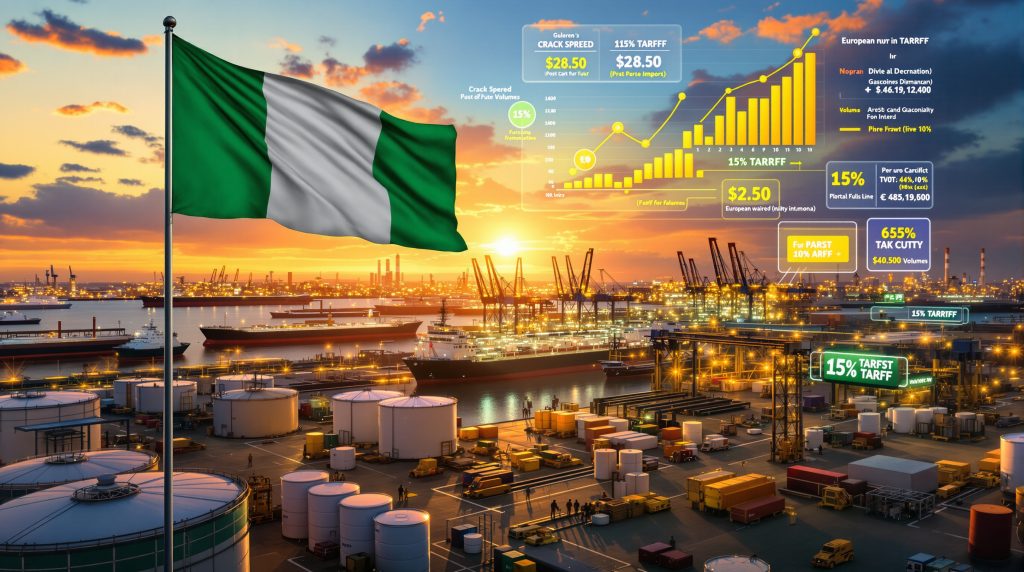Understanding Gasoline Crack Spreads and Their Market Significance
Gasoline crack spreads function as the fundamental profit indicator for refineries worldwide, measuring the differential between refined gasoline prices and crude oil input costs. The gasoline cracks Nigeria import tariff situation has created unprecedented market conditions that serve as a barometer for refining sector health and provide critical insights into supply-demand dynamics within global energy markets.
Current market conditions have propelled gasoline crack spreads to extraordinary levels, reaching $28.50 per barrel against ICE Brent crude as of November 2025. This represents the highest margin achieved since August 31, 2023, marking a significant 26-month peak that reflects underlying structural changes in global refined product markets.
The Mechanics of Crack Spread Calculations
The standard methodology for calculating gasoline crack spreads involves several key components that reflect true refining economics:
Basic Calculation Framework:
- Gasoline wholesale price minus crude oil cost equals gross crack spread
- Adjustments for yield ratios (typically 3:1 crude to product conversion)
- Regional basis differentials for local market conditions
- Quality specifications and octane premium adjustments
Current Market Data (November 2025):
- Eurobob gasoline assessments: $761 per tonne (highest since mid-June)
- ICE Brent crude futures: $62.86 per barrel (down $2.39 on the day)
- Crack spread differential: $28.50 per barrel (up 24% daily)
These elevated spreads translate to substantial profitability improvements for refiners. A facility processing 100,000 barrels daily would generate approximately $2.85 million in gross crack spread margin from gasoline production alone at current levels. Furthermore, this compares to typical margins of $10-12 per barrel during normal market conditions.
The Perfect Storm Behind Multi-Year Crack Spread Highs
Multiple converging factors have created an unprecedented environment for gasoline crack expansion. Nigeria import tariff effects serve as the catalyst for broader supply-demand imbalances across international markets, while US tariff impacts create additional complexity for global trading patterns.
Supply-Side Constraints Creating Market Tension
European refining capacity faces significant operational challenges that extend beyond typical seasonal patterns. Litasco refinery assets, representing approximately 2% of continental European refining capacity, operate under uncertainty due to geopolitical complications. This capacity removal coincides with planned maintenance programs across multiple European facilities, creating a supply bottleneck effect.
Terminal Infrastructure Disruptions:
- Gasoline loading delays reported since late September 2025
- European export terminals operating below optimal throughput
- Cargo accumulation creating secondary supply chain pressures
- Extended loading windows increasing vessel demurrage costs
Accelerated Demand from West African Import Surge
Market participants describe West African import activity as unprecedented. One European trader noted that the region is "pulling pretty much everything" from available European gasoline supplies. This demand surge stems directly from anticipatory purchasing ahead of Nigeria import tariff implementation.
Regional Demand Factors:
- Nigerian importers actively securing cargoes before tariff effective date
- Seasonal demand increases typical during pre-Christmas periods
- Egypt's EGPC issuing tenders for 7 handy-size gasoline cargoes (4 for January, 3 for February 2026)
- Additional West African nations increasing strategic inventory builds
The convergence of supply constraints with artificial demand acceleration has created market conditions not witnessed since the August 2023 peak. However, this follows patterns observed in commodity market volatility during similar policy implementation periods.
Nigeria Import Tariff Implementation and Market Response
Nigeria's comprehensive import tariff policy represents a fundamental shift toward energy security and domestic refining protection. The government has implemented a 15% tariff on CIF value for both gasoline and diesel imports, creating immediate market disruptions and long-term structural changes.
Policy Framework and Implementation Details
| Component | Specification | Market Impact |
|---|---|---|
| Tariff Rate | 15% on CIF value | Cost increase of ~$0.07 per liter |
| Product Coverage | Gasoline and diesel | Complete refined product scope |
| Grace Period | 30 days for in-transit shipments | Creates purchasing window urgency |
| Implementation | November 2025 (pending notification) | Policy ambiguity driving early imports |
The ambiguous implementation timeline has intensified import purchasing activity. Traders seek to avoid tariff costs through accelerated cargo bookings, with one Nigerian-based trader indicating that importers were "scrambling" to secure product before formal policy activation.
Economic Rationale and Strategic Objectives
Nigeria's tariff policy aims to address multiple strategic objectives while transforming the country's energy import dependency structure. Additionally, these changes align with broader tariff policy impacts observed globally.
Primary Policy Goals:
- Energy Security Enhancement: Reducing reliance on imported refined products
- Domestic Industry Protection: Supporting local refining capacity development
- Foreign Exchange Conservation: Minimising hard currency outflows for fuel imports
- Strategic Autonomy: Decreasing vulnerability to international supply disruptions
Historical Import Context:
Nigeria has traditionally imported approximately 67% of consumed gasoline. European refiners supplied the majority of West African demand through established trade relationships built on price competition rather than strategic partnerships.
The tariff implementation creates a protected market environment that fundamentally alters purchasing decisions. Consequently, sourcing shifts from price-competitive to policy-driven, representing a broader trend toward energy nationalism across emerging economies.
Global Refining Economics Transformation
The Nigerian import tariff represents more than a regional trade adjustment; it signals a paradigm shift in global refining economics. This policy change creates ripple effects throughout international refined product trade flows and investment patterns, similar to how oil price movements affect global market dynamics.
European Refiner Benefit Analysis
Current crack spread elevations provide substantial margin improvements for European refiners. These conditions create favourable environments for both operational optimisation and capital investment planning:
Immediate Financial Impact:
- Crack spreads at $28.50/barrel represent 185% increase over typical 2024 averages
- Enhanced cash flow generation supporting facility maintenance and upgrades
- Improved project economics for capacity expansion considerations
- Extended profitability windows supporting strategic planning horizons
Investment Incentive Structure:
At current margin levels, refineries can justify capital investments with 3-5 year payback periods. This encourages debottlenecking projects to increase throughput capacity, delayed coker and hydrotreating unit expansions, and extension of planned maintenance to maintain elevated run rates.
West African Market Restructuring
The tariff implementation initiates a comprehensive transformation of West African energy markets. Furthermore, implications extend well beyond immediate price impacts:
The shift from price-competitive importing to tariff-protected domestic sourcing represents a fundamental change in regional energy economics that will persist long after current crack spread elevations normalise.
Projected Market Changes (2025-2027):
- Import Volume Reduction: 25-30% decline in refined product imports
- Domestic Refining Growth: Increased capacity utilisation as protected market develops
- Price Structure Changes: 15-20% premium for imported products post-tariff implementation
- Supply Chain Restructuring: Development of alternative sourcing arrangements and logistics networks
Investment Flow Redistribution
The policy change creates significant capital allocation opportunities across multiple sectors:
Refining Sector Opportunities:
- Enhanced asset valuations in the European refining sector
- Improved economics for Nigerian domestic refining expansion
- Strategic positioning opportunities for integrated oil companies
- Premium pricing potential for flexible supply arrangements
Trading and Logistics Advantages:
- Arbitrage opportunities between tariff-protected and open markets
- Strategic inventory management becoming increasingly valuable
- Premium positioning for companies with flexible supply arrangements
- Enhanced importance of long-term supply contracts
Volatility Mechanisms and Market Structure Changes
Import tariffs create artificial supply constraints that amplify crack spread volatility through several interconnected mechanisms. Understanding these dynamics provides crucial insight into market behaviour during policy-driven structural changes.
Supply Concentration Effects
When major importing regions implement protective tariffs, the pool of economically viable suppliers contracts significantly. This concentration grants remaining suppliers enhanced price discovery power, as importers cannot easily substitute alternative sources.
Market Structure Impact:
- Reduced competition among suppliers in non-tariff regions
- Increased price inelasticity as switching costs rise
- Enhanced bargaining power for suppliers with established logistics networks
- Premium pricing sustainability due to limited alternatives
The Litasco capacity uncertainty compounds this effect by removing approximately 2% of European refining capacity from normal operations. Consequently, this further concentrates available supply among fewer market participants.
Time-Sensitive Demand Dynamics
Rush-to-import behaviour creates temporary demand spikes that exceed typical market absorption capacity. These artificial demand surges persist until several market adjustment mechanisms restore equilibrium:
- Inventory Accumulation Completion: Importers reach optimal storage levels
- Alternative Supply Development: New sourcing arrangements from non-tariff regions
- Demand Destruction: Higher prices reduce consumption volumes
- Policy Adaptation: Market participants adjust to new regulatory environment
Historical analysis suggests policy-driven crack spread elevations typically persist for 6-18 months. This depends on market adaptation speed and the development of alternative supply arrangements.
Market Efficiency Degradation
Import tariffs reduce overall market efficiency through multiple channels:
Price Signal Distortion:
- Prices reflect tariff costs rather than pure supply-demand fundamentals
- Reduced ability for market forces to optimise resource allocation
- Artificial price floors creating sustained premium pricing
Transaction Cost Increases:
- Enhanced documentation requirements for tariff compliance
- Origin certification adding administrative complexity
- Increased legal and regulatory compliance costs
- Extended transaction settlement periods
West Africa's Energy Import Evolution
The transformation of West African gasoline import patterns illustrates how policy changes can rapidly restructure established international trade relationships. Nigeria's position as the region's largest economy makes this shift particularly significant for global refined product markets.
Historical Trade Relationship Structure
Pre-tariff market dynamics were characterised by price-competitive sourcing from European refiners. Purchasing decisions were driven primarily by landed cost optimisation rather than strategic considerations:
Traditional Import Framework:
- European refiners supplied majority of West African gasoline demand
- Competitive bidding processes determined supplier selection
- Flexible sourcing arrangements based on spot market conditions
- Limited long-term supply contract prevalence
Import Dependency Metrics:
- Nigeria imported approximately 67% of consumed gasoline
- Regional import volumes concentrated in 4-5 major supplier relationships
- Seasonal demand patterns driving quarterly import volume fluctuations
- Limited domestic refining capacity utilisation
These patterns closely followed the current oil price analysis which indicated structural dependency on international markets.
Post-Tariff Market Projections
The implementation of import tariffs initiates a comprehensive market restructuring process. Moreover, implications extend well beyond immediate price impacts:
Two-Year Outlook (2025-2027):
- Import Volume Decline: Projected 25-30% reduction in refined product imports
- Domestic Capacity Utilisation: Expected increases as protected market develops
- Price Premium Structure: 15-20% markup for imported gasoline products
- Supply Chain Reconfiguration: Development of alternative sourcing and logistics networks
Strategic Implications for Regional Energy Security:
The shift toward domestic refining protection creates enhanced energy security through reduced import dependency. However, this requires substantial investment in local infrastructure development and technological capacity building.
Comparative Regional Analysis
Similar tariff implementations in other emerging economies provide insights into potential outcomes and adjustment timelines:
Historical Precedents:
- South African fuel tariffs (2018-2020): 18-month adjustment period for market stabilisation
- Indian import duties on refined products: 12-15% domestic capacity utilisation increases
- Brazilian biofuel mandates: 6-month initial volatility period followed by structural adjustment
These precedents suggest Nigeria's market adjustment will likely follow a 12-18 month transition period before achieving new equilibrium conditions.
Investment Implications and Strategic Positioning
Current market conditions create both opportunities and risks for various participants across the refined products value chain. Understanding these dynamics becomes crucial for strategic decision-making in an evolving policy environment.
Refining Sector Investment Opportunities
Elevated crack spreads provide compelling economics for both operational optimisation and capacity expansion across multiple regions:
European Refining Benefits:
- Enhanced Cash Flow Generation: Current margins support accelerated capital investment programmes
- Improved Project Economics: Capacity expansion projects achieve favourable return profiles
- Asset Valuation Increases: Refining assets command premium pricing in current environment
- Strategic Positioning Advantages: Early investment in flexible capacity provides long-term competitive benefits
According to Argus Media analysis, "gasoline cracks have been propelled to a 26-month high on the back of strong demand and tighter supply conditions".
West African Refining Development:
- Protected Market Access: Tariff policy creates favourable environment for domestic refining investment
- Import Substitution Opportunities: Reduced competition from European suppliers
- Government Support: Policy alignment with domestic industry development objectives
- Infrastructure Investment: Enhanced economics for refining capacity and supporting logistics development
Trading and Supply Chain Optimisation
Market volatility creates significant opportunities for companies with flexible supply arrangements and strategic positioning capabilities:
Arbitrage Positioning:
- Regional Price Differentials: Sustained premiums between tariff-protected and open markets
- Timing Arbitrage: Inventory positioning ahead of policy implementation deadlines
- Quality Arbitrage: Premium pricing for products meeting specific regional requirements
- Logistics Arbitrage: Competitive advantages for companies with established distribution networks
Risk Management Considerations
Several risk factors require careful evaluation when developing investment strategies in the current environment:
Policy Reversal Risks:
- Potential for tariff modifications based on consumer price impacts
- Political pressure from inflation concerns affecting fuel costs
- International trade dispute possibilities creating policy uncertainty
- Regional policy coordination affecting competitive positioning
Market Adaptation Threats:
- Development of alternative supply sources reducing European dependence
- Demand destruction from higher consumer prices affecting volume growth
- Competitive responses from alternative suppliers seeking market share
- Technology disruption affecting long-term demand patterns
Strategic Market Outlook and Investment Positioning
The convergence of Nigeria import tariff policy with global supply constraints creates a unique investment environment. This is characterised by both exceptional opportunities and significant risks, requiring careful navigation from market participants.
Duration and Sustainability Analysis
Historical patterns suggest that policy-driven crack spread elevations typically persist for 6-18 months. Sustainability depends on several critical factors:
Sustainability Drivers:
- Alternative Supply Development Timeline: 12-18 months for new sourcing arrangements
- Inventory Cycle Completion: 4-6 months for optimal storage level achievement
- Demand Response Elasticity: Consumer price sensitivity affecting volume patterns
- Policy Implementation Consistency: Government commitment to tariff maintenance
Market Adjustment Indicators:
- Crack spread normalisation toward historical ranges ($12-18/barrel)
- Alternative supplier emergence from Middle East and Asian refiners
- Domestic refining capacity additions in West African markets
- Consumer demand response to higher retail fuel prices
Long-term Structural Changes
Beyond immediate crack spread impacts, Nigeria import tariff implementation represents a broader trend. This extends toward energy security prioritisation across multiple emerging economies:
Global Policy Trends:
- Energy Security Prioritisation: Reduced reliance on imported refined products
- Domestic Industry Protection: Strategic support for local refining development
- Supply Chain Diversification: Decreased dependency on single-source suppliers
- Regional Energy Autonomy: Enhanced control over critical energy infrastructure
These structural changes suggest sustained alterations to global refined product trade flows. In addition, implications extend well beyond current elevated crack spread levels.
Strategic Investment Framework
Successful navigation of current market conditions requires a comprehensive approach. This must balance immediate opportunity capture with long-term strategic positioning:
Near-term Strategies (6-12 months):
- Margin Capture: Optimise refining operations to maximise crack spread benefits
- Inventory Positioning: Strategic product storage to capture price premiums
- Trading Optimisation: Exploit arbitrage opportunities between regional markets
- Hedging Strategies: Protect against potential crack spread normalisation
Medium-term Positioning (1-3 years):
- Capacity Investment: Strategic refining capacity additions in favourable regulatory environments
- Supply Chain Development: Alternative sourcing arrangement establishment
- Market Entry: Strategic positioning in protected domestic markets
- Technology Investment: Operational efficiency improvements supporting competitive positioning
Nigeria's 15% import tariff has catalysed gasoline cracks Nigeria import tariff conditions to 26-month highs. This creates exceptional market conditions that reflect broader structural changes in global energy trade patterns. Reuters reports that Nigeria imposes 15% import duty on petrol and diesel to support local refiners, highlighting the policy's strategic intent.
The policy represents more than a regional adjustment; it signals a paradigm shift toward energy security prioritisation. Consequently, this will reshape international refined product markets for years to come.
Market participants who understand these dynamics and position accordingly will benefit from both immediate margin opportunities and long-term structural advantages. However, success requires careful attention to policy developments, supply chain flexibility, and strategic positioning to capitalise on evolving market structures while managing inherent risks in this transformative environment.
As similar energy security policies emerge across other regions, the relationship between trade policy and commodity pricing becomes increasingly critical for market participants across the entire energy value chain.
Want to Capitalise on Commodity Market Volatility?
Discovery Alert's proprietary Discovery IQ model delivers real-time alerts on significant ASX mineral discoveries, instantly transforming complex commodity data into actionable insights for traders and investors. With current market volatility creating exceptional opportunities across energy and mineral sectors, explore Discovery Alert's proven track record of identifying major discoveries and begin your 30-day free trial today to position yourself ahead of the market.




